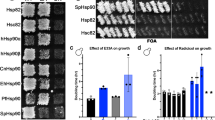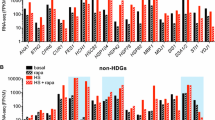Summary
We have isolated a new small heat shock gene, HSP12, from Saccharomyces cerevisiae. It encodes a polypeptide of predicted Mr 12 kDa, with structural similarity to other small heat shock proteins. HSP12 gene expression is induced several hundred-fold by heat shock and on entry into stationary phase. HSP12 mRNA is undetectable during exponential growth in rich medium, but low levels are present when cells are grown in minimal medium. Analysis of HSP12 expression in mutants affected in cAMP-dependent protein phosphorylation suggests that the gene is regulated by cAMP as well as heat shock. A disruption of the HSP12 coding region results in the loss of an abundant 14.4 kDa protein present in heat shocked and stationary phase cells. It also leads to the induction of the heat shock response under conditions normally associated with low-level HSP12 expression. The HSP12 disruption has no observable effect on growth at various temperatures, nor on the ability to acquire thermotolerance.
Similar content being viewed by others
References
Ananthan J, Goldberg AL, Voellmy R (1986) Abnormal proteins serve as eukaryotic stress signals and trigger the activation of heat shock genes. Science 232:522–524
Bennetzen JL, Hall BD (1982) Codon selection in yeast. J Biol Chem 257:3029–3031
Berger EM, Woodward MP (1983) Small heat shock proteins in Drosophila may confer thermal tolerance. Exp Cell Res 147:437–442
Borkovich KA, Farrelly FW, Finkelstein DB, Taulien J, Lindquist S (1989) Hsp82 is an essential protein that is required in higher concentrations for growth of cells at higher temperatures. Mol Cell Biol 9:3919–3930
Bossier P, Fitch IA, Boucherie H, Tuite MF (1989) Structure and expression of a yeast gene encoding the small heat shock protein, Hsp26. Gene 78:323–330
Botstein D, Falco SC, Stewart SE, Brennan M, Scherer S, Stinchcomb DT, Struhl K, Davies RW (1979) Sterile host yeasts (SHY): A eukaryotic system of biological containment for recombinant DNA experiments. Gene 8:17–24
Chirico WJ, Waters MG, Blobel G (1988) 70K heat shock related proteins stimulate protein translocation into microsomes. Nature 332:805–810
Cigan AM, Donahue TF (1987) Sequence and structural features associated with translational initiator regions in yeast — a review. Gene 59:1–18
Craig EA, Jacobsen K (1984) Mutations of the heat inducible 70 kilodalton genes of yeast confer temperature sensitive growth. Cell 38:841–849
Craig EA, Jacobsen K (1985) Mutations in cognate genes of Saccharomyces cerevisiae hsp70 result in reduced growth rates at low temperatures. Mol Cell Biol 5:3517–3524
Deshaies RJ, Koch BD, Werner-Washburne M, Craig EA, Schekman R (1988) A subfamily of stress proteins facilitates translocation of secretory and mitochondrial precursor polypeptides. Nature 332:800–805
DiDomenico BJ, Bugaisky GE, Lindquist S (1982) The heat shock response is self-regulated at both the transcriptional and post-transcriptional levels. Cell 31:593–603
Dobson MJ, Tuite MF, Roberts NA, Kingsman AJ, Kingsman SM (1982) Conservation of high efficiency promoter sequences in Saccharomyces cerevisiae. Nucleic Acids Res 10:2625–2637
Feinberg AP, Vogelstein B (1983) A technique for radiolabelling DNA restriction endonuclease fragments to high specific activity. Anal Biochem 132:6–13
Finley D, Oezkaynak E, Varshavsky A (1987) The yeast polyubiquitin gene is essential for resistance to high temperatures, starvation, and other stresses. Cell 48:1035–1046
Frischauf AM, Lehrach H, Poustka A, Murray NM (1983) Lambda replacement vectors carrying polylinker sequences. J Mol Biol 170:827–842
Fujita T, Ohno S, Yasumitsu H, Taniguchi T (1985) Delimitation and properties of DNA sequences required for the regulated expression of human interferon-β gene. Cell 41:489–496
Grant CM, Firoozan M, Tuite MF (1989) Mistranslation induces the heat-shock response in the yeast Saccharomyces cerevisiae. Mol Microbiol 3:215–220
Hames BD (1981) In: Hames BD, Rickwood D (eds) Gel electrophoresis of proteins. A practical approach. IRL Press, Oxford, pp 1–91
Iida H, Yahara I (1984) Durable synthesis of high molecular weight heat shock proteins in Go cells of the yeast and other eukaryotes. J Cell Biol 99:199–209
Ingolia TD, Craig EA (1982) Four small Drosophila heat shock proteins are related to each other and to mammalian α-crystallin. Proc Natl Acad Sci USA 79:2360–2364
Kyte J, Doolittle RF (1982) A simple method for displaying the hydrophobic character of a protein. J Mol Biol 157:105–132
Lindquist S (1986) The heat-shock response. Annu Rev Biochem 55:1151–1191
Lindquist S, Craig EA (1988) The heat-shock proteins. Annu Rev Genet 22:631–677
Loomis WF, Wheeler SA (1982) Chromatin-associated heat shock proteins of Dictyostelium. Dev Biol 90:412–418
Makara MP, Henson JM (1985) BLOTTO for dried agarose gels. Focus 8:14–15
Maniatis T, Fritsch EF, Sambrook J (1982) Molecular cloning: a laboratory manual. Cold Spring Harbor Laboratory Press, Cold Spring Harbor, New York
Matsumoto K, Uno I, Ishikawa T (1985) Genetic analysis of the role of cAMP in yeast. Yeast 1:15–24
McAlister L, Finkelstein DB (1980) Heat shock proteins and thermal resistance in yeast. Biochem Biophys Res Commun 93:819–824
Normington K, Kohno K, Kozutsumi Y, Gething M-J, Sambrook J (1989) S. cerevisiae encodes an essential protein homologous in sequence and function to mammalian Pip. Cell 57:1233–1236
Oezkaynak E, Finley D, Solomon MJ, Varshavsky A (1987) The yeast ubiquitin genes: a family of natural gene fusions. EMBO J 6:1429–1439
Ostermann J, Horwich AL, Neupert W, Hard F-U (1989) Protein folding in mitochondria requires complex formation with hsp60 and ATP hydrolysis. Nature 341:125–130
Pelham HRB (1989) Heat shock and the sorting of luminal ER proteins. EMBO J 8:3171–3176
Petko L, Lindquist S (1986) Hsp26 is not required for growth at high temperatures, nor for thermotolerance, spore development, or germination. Cell 45:885–894
Proudfoot NJ, Brownlee GG (1976) 3′Non-coding region sequences in eukaryotic messenger RNA. Nature 263:211–214
Raschke E, Baumann G, Schoeffl F (1988) Nucleotide sequence analysis of soybean small heat shock protein genes belonging to two different multigene families. J Mol Biol 199:549–557
Riddihough G, Pelham HRB (1986) Activation of the Drosophila hsp27 promoter by heat shock and by ecdysone involves independent and remote regulatory sequences. EMBO J 5:1653–1658
Rothstein RJ (1983) One-step gene disruption in yeast. Methods Enzymol 101:202–210
Sanger F, Nicklen S, Coulson AR (1977) DNA sequencing with chain-terminating inhibitors. Proc Natl Acad Sci USA 74:5463–5467
Sarokin L, Carlson M (1986) Short repeated elements in the upstream regulatory region of the SUC2 gene of Saccharomyces cerevisiae. Mol Cell Biol 6:2324–2333
Schlesinger MJ (1986) Heat shock proteins: The search for functions. J Cell Biol 103:321–325
Sharp PM, Tuohy TMF, Mosurski KR (1986) Codon usage in yeast: cluster analysis clearly differentiates highly and lowly expressed genes. Nucleic Acids Res 14:5125–5143
Sherman F, Fink GR, Hicks JB (1986) Laboratory course manual for methods in yeast genetics. Cold Spring Harbor Laboratory Press, Cold Spring Harbor, New York
Sorger PK, Pelham HRB (1987) Purification and characterisation of a heat shock element binding protein from yeast. EMBO J 6:3035–3041
Sorger PK, Pelham HRB (1988) Yeast heat shock factor is an essential DNA-binding protein that exhibits temperatur dependent phosphorylation. Cell 54:855–864
Struhl K (1986) In: Reznikoff W, Gold L (eds) From gene to protein: Steps dictating the maximal level of gene expression. Butterworth Publishing Co, Boston, pp 35–78
Struhl K (1987) Promoters, activator proteins, and the mechanism of transcriptional initiation in yeast. Cell 49:295–297
Tanaka K, Matsumoto K, Toh-e A (1988) Dual regulation of the expression of the polyubiquitin gene by cyclic AMP and heat shock in yeast. EMBO J 7:495–502
Tuite MF, Bossier P, Fitch IT (1988) A highly conserved sequence in yeast heat shock gene promoters. Nucleic Acids Res 16:11845
Vieira J, Messing J (1982) The pUC plasmids, and M13mp7-derived system for insertion mutagenesis and sequencing with universal primers. Gene 19:259–268
Werner-Washburne M, Stone DE, Craig EA (1987) Complex interactions among members of an essential subfamily of HSP70 genes in Saccharomyces cerevisiae. Mol Cell Biol 7:2568–2577
Werner-Washburne M, Becker J, Kosic-Smithers J, Craig EA (1989) Yeast Hsp70 RNA levels vary in response to the physiological status of the cell. J Bacteriol 171:2680–2688
Wu BJ, Kingston RE, Morimoto RI (1986) Human HSP70 promoter contains at least two distinct regulatory domains. Proc Natl Acad Sci USA 83:629–633
Yanisch-Perron C, Vieira J, Messing J (1985) Improved M13 phage cloning vectors and host strains: nucleotide sequences of the M13mp18 and pUC19 vectors. Gene 33:103–119
Zaret KS, Sherman F (1982) DNA sequence required for efficient transcription termination in yeast. Cell 28:563–573
Author information
Authors and Affiliations
Additional information
Communicated by C.P. Hollenberg
Rights and permissions
About this article
Cite this article
Praekelt, U.M., Meacock, P.A. HSP12, a new small heat shock gene of Saccharomyces cerevisiae: Analysis of structure, regulation and function. Mol Gen Genet 223, 97–106 (1990). https://doi.org/10.1007/BF00315801
Received:
Issue Date:
DOI: https://doi.org/10.1007/BF00315801




